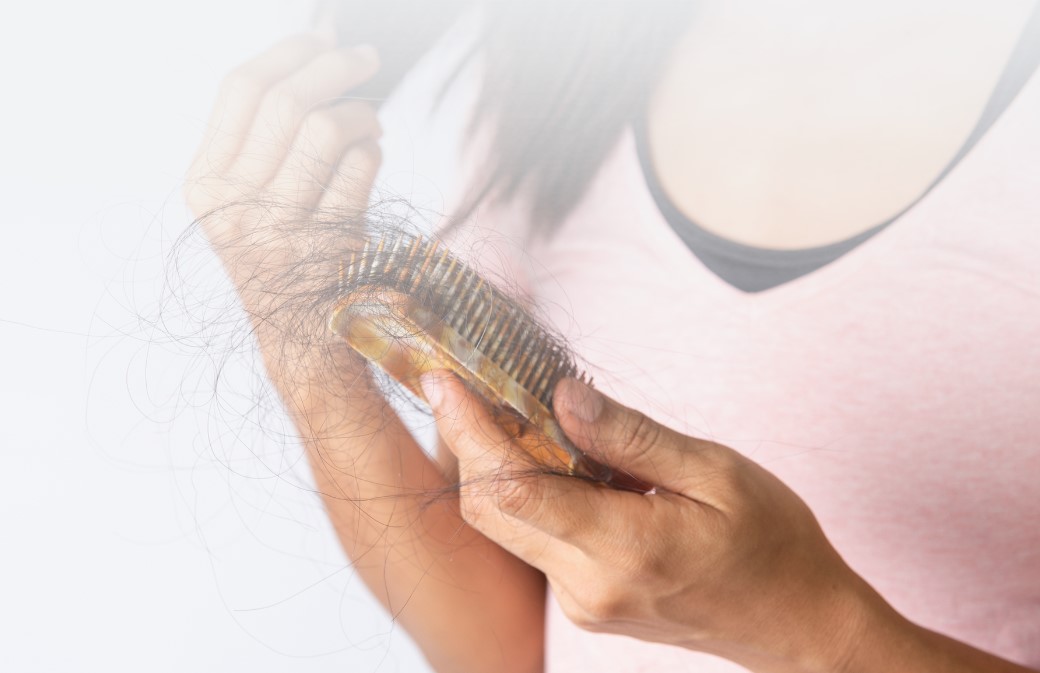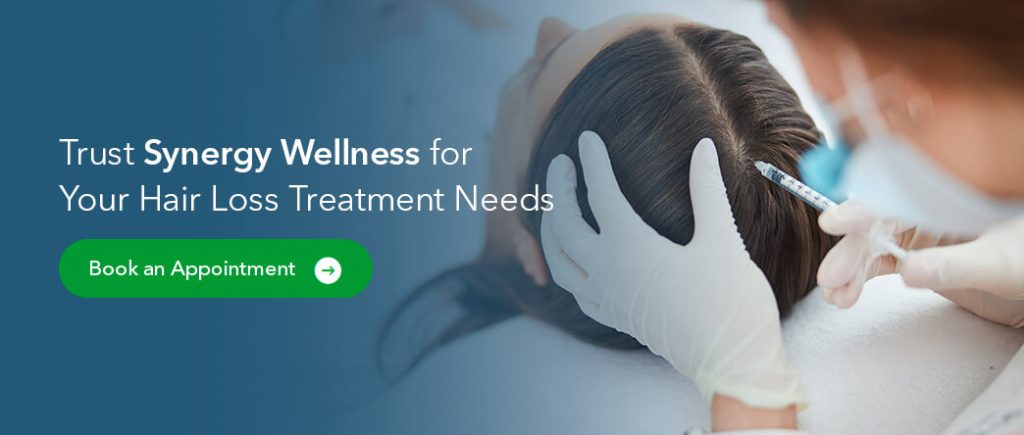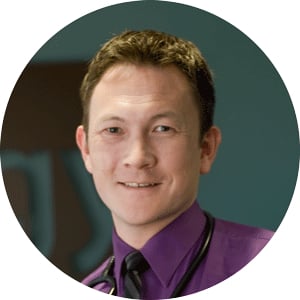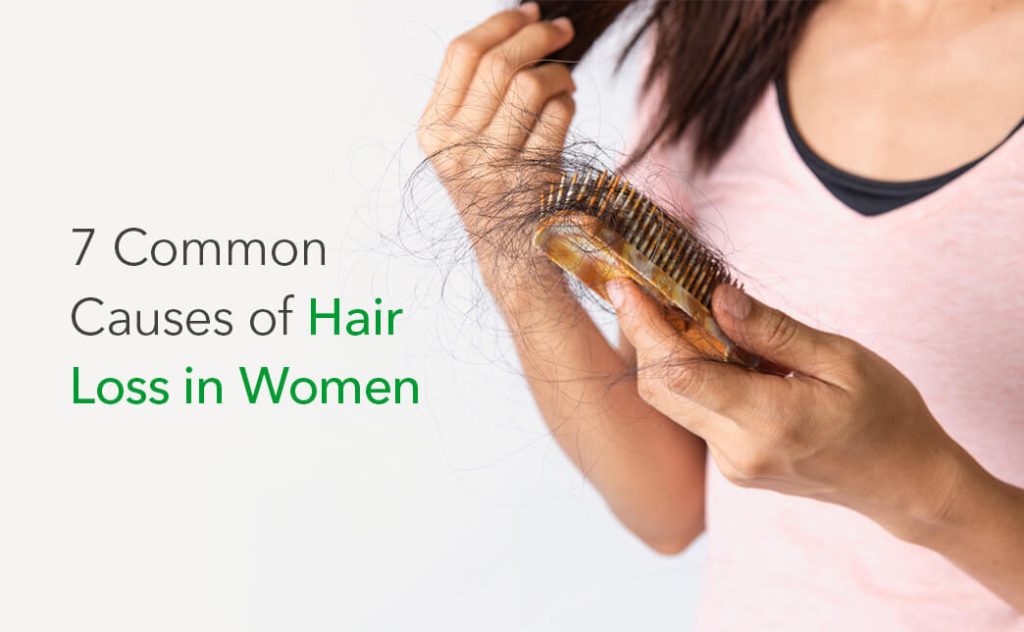
On average, humans shed around 100 hairs each day, which may seem like a lot, but it’s actually completely normal. You’re most likely dealing with hair loss when you start shedding more than 125 hairs daily. While hair loss is often attributed to signs of aging, many other causes can cause you to start losing hair at any age.
Losing hair can impact a person’s confidence and self-esteem, but the good news is that there are ways to prevent it from happening or getting worse. Many treatments are available to women experiencing different types of hair loss, helping them regain their confidence without impacting their ability to go about their day. Below, you’ll learn about the types of hair loss that affect women, the causes and what you can do to prevent hair loss.
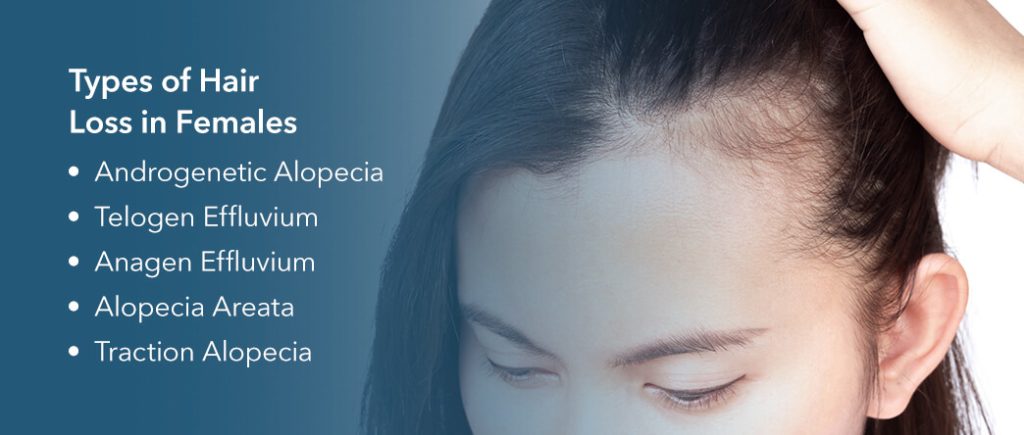
Types of Hair Loss in Females
When a woman loses an excessive or abnormal amount of hair, it’s known as alopecia, and there are many forms of the condition. Excessive shedding can also be attributed to genes and illnesses that cause hair loss in females. The different types of delayed or sudden hair loss in women include:
- Androgenetic Alopecia: This hair loss has diffuse thinning all over the scalp that results from genetic sensitivity to androgens, or male hormones. These hormones can also be triggered by other conditions, such as ovarian cysts, some birth control pills, menopause and pregnancy. Genetics plays a significant factor in a woman developing this type of alopecia, often called female pattern baldness.
- Telogen Effluvium: This hair loss often occurs after a traumatic experience, such as childbirth, major surgery, extreme stress or malnutrition. Hairs in the growing phase can shift to the resting stage, which a person will notice a few months after the traumatic event. A person with the most severe case of this condition can lose handfuls of hair at a time.
- Anagen Effluvium: This hair loss occurs when hair follicles become impaired, often associated with chemotherapy. The treatment can affect your hair’s growing phase, causing them to fall out.
- Alopecia Areata: An inappropriate inflammatory reaction usually causes hair loss, often when a person’s immune system attacks the hair follicles and causes damage to the growing hairs. Women with this type of hair loss may experience patchiness. After some time, a person can start to recover their hair as the immune system rebalances.
- Traction Alopecia: This alopecia is caused by trauma to hair follicles, often from tight hairstyles. If a woman detects traction alopecia early enough and remedies the situation, she can reverse the effects.
Some types of hair loss are temporary and can return to normal after the event causing the hair loss ends. For example, women who have lost their hair from stress will likely experience regrowth once the stressful period has passed. Other causes may be more permanent, such as female pattern baldness. However, some treatments can help encourage hair growth in most women, so it’s always a good idea to consult a dermatologist to determine your treatment options.
When Are Women Most Likely to Experience Hair Loss?
Due to the stigma surrounding male pattern baldness, most people think hair loss is more likely to affect men or that it’s just a men’s issue. Studies show that over 50% of women will experience hair loss in their lifetime. While any girl can be affected by hair loss, it’s more common among:
- Women over 40.
- Women who have just given birth.
- Women who have undergone chemotherapy treatment or been affected by certain medications, like specific birth control.
- Women who pull their hair into tight hairstyles or use harsh chemicals regularly.
- Women going through menopause.
There are also plenty of myths about hair loss in women. Some of these myths include the following:
- You can lose your hair from using too much shampoo, hair dye or getting perms.
- Dandruff contributes to permanent hair loss.
- Stress causes permanent hair loss.
- Shaving your head can help your hair grow back twice as thick as before.
- Brushing 100 times a day makes your hair healthier.
- Doing headstands can increase circulation and hair growth.
- Wearing wigs or hats can promote hair loss.
None of the above is true and can’t help or harm a person’s risk of experiencing hair loss.
7 Causes of Hair Loss in Women
There are multiple reasons for hair loss in women. Some women experience a combination of issues that result in hair loss, while others may only experience one. Learn more about the causes of hair thinning in women below.
1. Genetics
Androgenetic alopecia is an inherited condition that usually occurs as a person ages, but some people may experience it while they’re still in their teens. Typically, a person sheds hair, and it’s replaced by one of the same thickness. A person with androgenetic alopecia will experience hair regrowth that is finer and thinner than their previous hair. Over time, the hair will continue to shrink and eventually stop growing altogether.
2. Health Conditions
Sudden hair loss or losing normal-sized hair can be caused by something besides genetics, such as a medical condition. Many types of health conditions can cause hair loss, such as:
- Pregnancy
- Anemia
- Thyroid disorders
- Autoimmune disorders
- Polycystic ovary syndrome (PCOS)
- Seborrheic dermatitis
- Psoriasis and other skin conditions
A symptom of these health conditions sometimes includes hair loss, which can be compounded by other factors, such as genetics, stress and medical treatments.
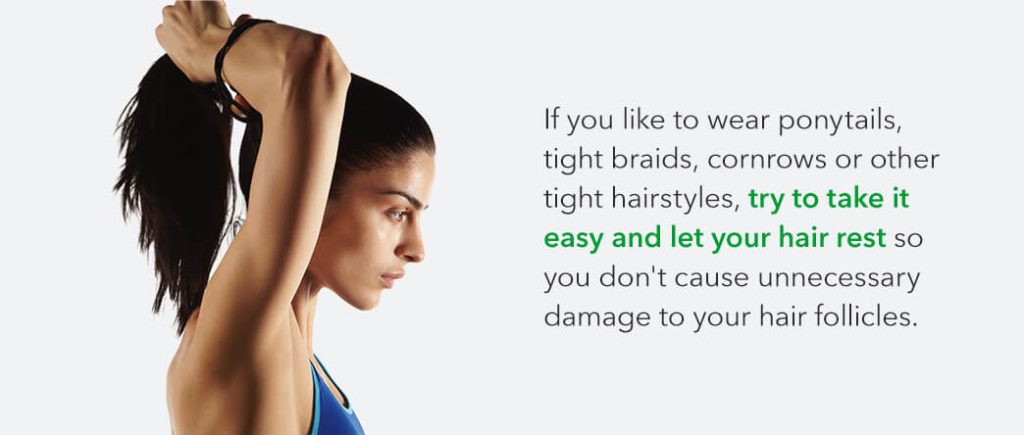
3. Hairstyles
Consistently wearing tight hairstyles can cause trauma to your hair follicles, causing traction alopecia. If you like to wear ponytails, tight braids, cornrows or other tight hairstyles, try to take it easy and let your hair rest so you don’t cause unnecessary damage to your hair follicles.
There are other ways that you can cause damage to your hair, such as using too much dye, chemicals, flat irons, blow dryers or bad hair brushes. These factors can cause damage and breakage.
For many of these issues, a woman can get her hair to grow back once she stops using these items too frequently. Medical treatments can also help encourage hair growth, and the sooner you spot the signs and seek treatment, the easier it will be to come back from hair loss.
4. Specific Treatments
Some medical treatments and medications can also cause hair loss. Chemotherapy or radiation treatment impairs the hair follicles and can cause hair loss. These treatments can cause hair loss anywhere on the body, not just on the scalp. Sometimes these treatments can damage the hair follicles enough that the hair loss becomes permanent.
Some birth control can also cause hair loss, specifically in women sensitive to hormonal changes or those with genetic factors that can cause hair loss. Other medications that can cause hair loss include specific kinds of:
- Anticoagulant medications
- Blood pressure medications
- Beta-blockers
- Hormone replacement therapy drugs
- Anticonvulsants
- Antidepressants
5. Stress
Extreme physically or mentally stressful events can cause hair loss by triggering a stress hormone that affects the hair growth process. Stressful situations can include:
- Mental illness
- Loss of a loved one
- Extreme weight loss
- Loss of a loved one
- Childbirth
- Physical injury
Stress can also affect the body in other ways, such as high blood pressure, heart disease and diabetes. The good news is that hair loss from stress usually isn’t permanent and can start to reverse as time goes on. Some people will begin to see their hair growth return to normal just a few months after a stressful event, but you can always talk with a professional to learn how to encourage hair growth.
6. Aging
As women age, they start to produce fewer hormones, eventually leading to menopause. Menopause has numerous symptoms, including hot flashes, mood swings, sleep disturbances, weight gain and more. It has also been linked to hair loss, with one study noting that over 50% of postmenopausal women experience female pattern baldness.
Since menopause results from a decrease in your natural hormone production, it stands to reason that it would also affect your ability to grow hair. Spotting the signs of hair loss early and seeking effective treatment can help women going through menopause improve their quality of life.
7. Malnutrition
Many people diet to help them reach their weight loss or fitness goals. However, some people go too far with their dieting, restricting too much food and losing too much weight too fast. Others simply don’t get enough calories or the right amount of nutrients throughout the day. A person who becomes malnourished inches has an increased likelihood of experiencing hair loss.
If a person catches this hair loss early enough and determines the cause is malnutrition, they can potentially reverse the effects by changing their diet. You should always consult your doctor when making changes to your eating habits to ensure you get the correct amount of vitamins and minerals for a healthy life.
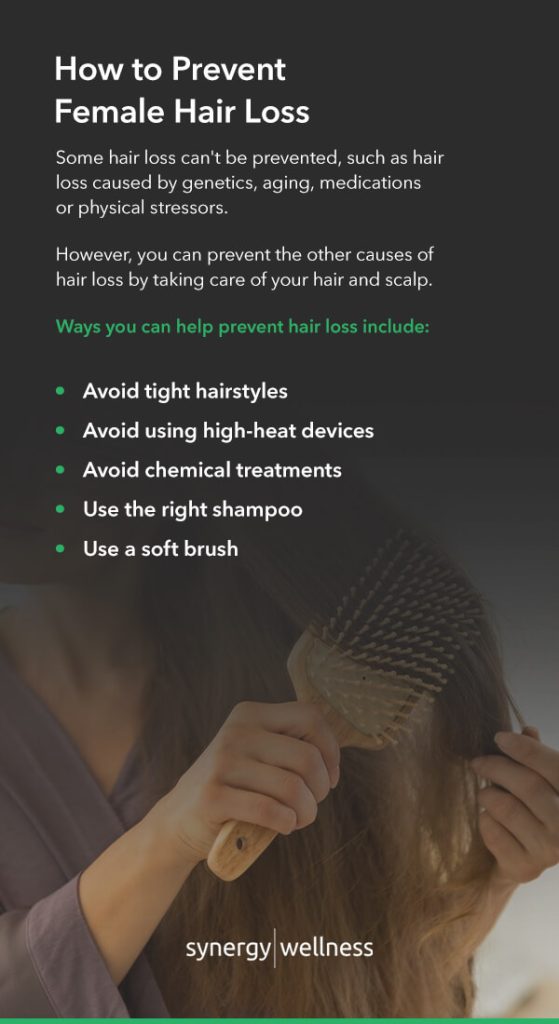
How to Prevent Female Hair Loss
Some hair loss can’t be prevented, such as hair loss caused by genetics, aging, medications or physical stressors. However, you can prevent the other causes of hair loss by taking care of your hair and scalp. Ways you can help prevent hair loss include:
- Avoid tight hairstyles: While hair is durable and can be stretched, it’s never a good idea to overdo it. Wearing tight hairstyles too often can cause you to lose your hair, so it’s better to let it loose occasionally. Ideally, you should wear your hair down more often than wearing it up.
- Avoid using high-heat devices: Excessive heat from flat or curling irons and blow dryers can cause your hair follicles to become dry and damaged, which can lead to hair loss. If you’re using hair dyers or irons daily, consider looking for alternative methods to style your hair to ensure it doesn’t sustain unnecessary damage.
- Avoid chemical treatments: Bleaching or dyeing your hair and getting chemical treatments too often can cause damage that can lead to hair loss. Try to limit the number of times you bleach, color and perm your hair to keep it healthy and prevent hair loss.
- Use the right shampoo: Overwashing your hair can strip it of the natural oils that prevent it from damage, leaving it dry and fractured. Some shampoos also contain sulfates, which are ingredients that can cause dryness and frizzy hair. Instead, wash your hair every few days with quality shampoo meant for your hair type to prevent unnecessary damage.
- Use a soft brush: Using a brush with natural fibers can help promote natural oils in your hair, which are essential for hydration. When you brush your hair, go in one direction from top to bottom to prevent friction, and brush daily while taking care not to overbrush your hair.
Using these methods, you can significantly reduce the risk of damage to your hair that can cause hair loss. You can also use techniques to reduce your stress, which can contribute to hair loss, such as:
- Meditation and mindfulness
- Exercise
- Yoga
- Journaling
- Connect with friends and family
- Get plenty of sleep and adequate hydration
- Spend time doing activities that bring you joy
Managing your stress and taking care of your hair are the best ways to prevent hair loss. If your hair loss is caused by genetics, medical conditions or similar factors, talk to a professional to determine your treatment options and how they can help you encourage hair growth.
Hair Loss Treatment for Women
There are different treatments for various types of hair loss, and the first step is consulting with a professional who understands how hair works and how to recognize what type of hair loss you’re experiencing.
Women can use an injectable hair-loss treatment that utilizes their own blood to encourage natural growth factors that promote hair growth. This treatment option is associated with minimal discomfort, helping you nurture hair growth without uncomfortable side effects. There’s no downtime after the injections. You can use ice packs for discomfort or bruising and take warm showers to boost circulation to help improve the outcome of your treatment.
Most women who experience hair loss are good candidates for this treatment, especially since it uses substances from your body. It’s most effective for women undergoing the early stages of hair loss, so it’s essential to see a professional when you first notice the signs. However, this treatment can benefit women at any stage of hair loss. The injectable treatment is a natural process, so it can be beneficial for many women. You should always consult a professional and discuss your health history before moving forward with the treatment to ensure it works for you.
Trust Synergy Wellness for Your Hair Loss Treatment Needs
If you’ve noticed the signs of hair loss or have been dealing with it for some time, Synergy Wellness is here to help! Hair loss can be frustrating and can cause a significant hit to your confidence. Our injectable hair loss treatment can help you return to your everyday life.
We use substances from your own body to encourage natural hair growth, making it an excellent treatment for most women. Our treatment has little to no side effects, letting you return to your usual activities without downtime. We’ll guide you through the entire treatment process and can give you a better idea of the results you can expect during your consultation. If you’re ready to boost your confidence, contact us today to learn how our hair loss treatment can revolutionize your life.


